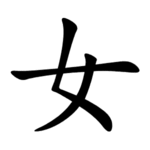Radical 38 or radical woman (
| ||
| Pronunciations | ||
| Pinyin: | nǚ | |
| Bopomofo: | ㄋㄩˇ | |
| Gwoyeu Romatzyh: | neu | |
| Wade–Giles: | nü3 | |
| Cantonese Yale: | néuih | |
| Jyutping: | neoi5 | |
| Pe̍h-ōe-jī: | lú | |
| Japanese Kana: | ジョ jo (on'yomi) おんな onna (kun'yomi) | |
| Sino-Korean: | 녀 (여) nyeo | |
| Names | ||
| Chinese name(s): | (Left) (Bottom) | |
| Japanese name(s): | ||
| Hangul: | 계집 gyejip | |
| Stroke order animation | ||
 | ||
In the Kangxi Dictionary, there are 681 characters (out of 49,030) to be found under this radical.
Evolution
edit-
Oracle bone script character
-
Bronze script character
-
Large seal script character
-
Small seal script character
Derived characters
edit| Strokes | Characters |
|---|---|
| +0 | |
| +2 | |
| +3 | 奷 奸 (also SC form of |
| +4 | 妉 |
| +5 | 妬JP (=妒) 妭 妮 妯 妰 妱 妲 妳 妴 妵 妶 妷 (= |
| +6 | 妍 姘 姙 (= |
| +7 | |
| +8 | 娬 娵 |
| +9 | 婷 婸 婹 (=偠 -> |
| +10 | 媐 媰 媱 媲 媳 媴 媵 媶 媷 媸 媹 媺 (= |
| +11 | 嫕 嫖 |
| +12 | 嫳 嫴 嫵 嫶 嫷 嫸 嫹 (=媌) 嫺 (=嫻) 嫻 嫼 嫽 嫾 嫿 嬀 (=媯) 嬁 嬂 嬃 嬄 嬅 嬆 嬇 嬈 |
| +13 | 嬐 嬑 嬒 嬓 嬔 嬕 嬖 嬗 嬘 嬙 嬚 嬛 嬜 嬝 (=裊 -> |
| +14 | 嬣 嬤 嬥 嬦 嬧 嬨 嬩 嬪 嬫 嬬 嬭 (=奶) 嬮 嬯 嬰 嬱 |
| +15 | 嬸 嬺 嬻 嬼 嬽 |
| +16 | 嬹 嬾 (= |
| +17 | 孀 孁 孂 |
| +18 | 孇 孈 孉 |
| +19 | 孊 孋 孌 |
| +20 | 孍 |
| +21 | 孎 孏 (= |
Controversies over sexism
editSome feminists have claimed that many Chinese characters under radical woman are pejorative,
In 2010, a mainland Chinese male lawyer posted an essay online, in which he criticized 16 Chinese characters for their sexist implication. The 16 characters were 娱 (娛, entertainment), 耍 (to play with, usually classified under radical 126 而), 婪 (greedy), 嫉 (envy), 妒 (envy),
In 2015, an exhibition in Beijing entitled "
A 2014 study done by Wang Yuping from Anhui University's School of Chinese Language and Literature analyzed all Chinese characters with the woman radical in a concise edition of Hanyu Da Cidian (汉语
Similar controversies also exist in "gendered" European languages which have divisions between masculine and feminine terms. This phenomenon is called linguistic sexism.
Character
editAlone the character is one of the Kyōiku kanji or Kanji taught in elementary school in Japan.[7] It is a first grade kanji.[7]
Literature
edit- Fazzioli, Edoardo (1987). Chinese calligraphy : from pictograph to ideogram : the history of 214 essential Chinese/Japanese characters. calligraphy by Rebecca Hon Ko. New York: Abbeville Press. ISBN 0-89659-774-1.
- Lunde, Ken (Jan 5, 2009). "Appendix J: Japanese Character Sets" (PDF). CJKV Information Processing: Chinese, Japanese, Korean & Vietnamese Computing (Second ed.). Sebastopol, Calif.: O'Reilly Media. ISBN 978-0-596-51447-1.
References
edit- ^ 邱慕
天 (2018-09-10). "漢字 歧視女性 《經濟 學 人 》認 應 重 新造 字 " [Chinese characters are sexist. The Economist proposed a reform of Chinese characters] (in Chinese (Taiwan)).台灣 醒報. - ^
黄玉 顺 (1994-03-04). "汉字里 的 性 别歧视" [Sexism in Chinese characters].中国 儒学 网 (in Chinese (China)). - ^ a b "
律 师认为16个汉字 歧视女性 建 议奸改 为犭行 " [Lawyer pointed out 16 sexist Chinese characters, proposed replacing 奸 with 犭行] (in Chinese (China)). 现代快 报. 2010-01-21 – via新 浪 新 闻. - ^
程 俊 (2010-01-22). ""奸"改 为"犭行"可 减少强 奸犯罪 为何很傻很天真 " [Why it is naive to think replacing "奸" with "犭行" would reduce rape] (in Chinese (Singapore)). 联合早 报. - ^ Didi Kirsten Tatlow (2015-12-02). "Enduring Prejudices of Gender Woven Into Chinese Language". The New York Times.
- ^
汪 宇平 (2014). "浅 谈汉语中的 女 部 字 与 中国 文化 的 性 别歧视" [A Brief Discussion Chinese Characters under Radical Woman and Gender Discrimination in Chinese Culture].安徽 文学 (in Chinese (China)) (372): 16–17. - ^ a b "The Kyoiku Kanji (
教育 漢字 ) - Kanshudo". www.kanshudo.com. Archived from the original on March 24, 2022. Retrieved 2023-05-06.